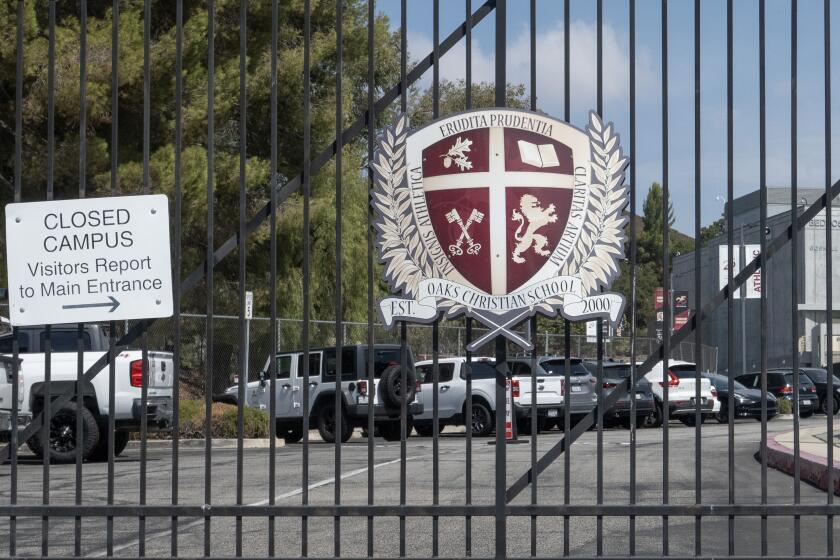Supervisors Take Confusing Steps on Growth Control
Launching a major growth-management push as dramatic as it is confusing, the San Diego County Board of Supervisors on Wednesday tentatively approved two ballot propositions on growth but defeated--at least temporarily--another proposal that would limit development on environmentally sensitive lands.
With the supervisors describing their actions in historic terms, the board took the first steps in a protracted legislative process that could lead to a half dozen local growth-control measures being placed on the November ballot.
By unanimous votes, the board instructed county administrators to draft ballot language for two potential propositions--one calling for creation of a regional growth-management board, the other establishing “quality of life standards” that would limit residential, commercial and industrial development in the unincorporated regions of the county. Proposed by Supervisors Brian Bilbray and George Bailey, respectively, those two measures will be before the board for final action next month.
A Narrow Rejection
But the supervisors narrowly rejected another major proposal--the product of extensive community and previous board meetings--designed to protect wetlands, flood plains, hillsides and other environmentally sensitive lands in the county’s unincorporated areas.
However, several of the three supervisors who opposed placing that issue on the ballot Wednesday--Bailey, Bilbray and John MacDonald--emphasized that they did so, not because of displeasure with the measure itself, but because they want more time to review the potential effect of several last-minute amendments. As a result, Supervisor Susan Golding, who has spearheaded the sensitive-lands proposal, expressed optimism that at least one of her colleagues will join her and Supervisor Leon Williams in supporting the measure at next month’s meeting.
Another source of Golding’s optimism is that, moments before voting against placing the sensitive lands measure on the ballot, the board unanimously approved an interim ordinance that encompasses the major components of that proposal. The purpose of the interim ordinance is to ensure that sensitive lands are not endangered by a rush of development proposals made before the Nov. 8 election.
Thus, to recap that confusing, somewhat contradictory series of votes, the supervisors opted not to put the sensitive lands measure on the November ballot but voted to protect those lands in the interim--and said that they may change their minds next month and place the issue on the ballot after all.
As murky as that is, there was little doubt by anyone at Wednesday’s meeting that the confusion is likely to be more mind-numbing by this fall’s election. Given the complexity of the subject itself, the multiple growth-management proposals that could end up on the ballot--plans that are complementary on some points, contradictory on others--are likely to be an indecipherable riddle to most voters, county officials and others concede.
4 Growth Proposals Possible
Combined with the slow-growth Rural Preservation Initiative expected to be on the November ballot, the measures being pushed by Golding, Bailey and Bilbray could confront countywide voters with four growth proposals. The initiative, for which Citizens for Limited Growth collected more than 80,000 signatures to qualify it on the ballot, would restrict development in unincorporated areas and protect rural communities from urbanization. Several similar growth proposals likely will be contested within the City of San Diego.
The supervisors--as well as developers, environmentalists and land-use lawyers deeply engrossed in the growth issue--concede that even they are confused over some of the specifics in the proposals and are uncertain over whether the competing proposals would neatly mesh or become the legislative equivalent of parts of a puzzle that do not fit.
A major unresolved legal question that adds to the confusion concerns what would happen if several--or all--of the countywide proposals are approved, particularly if they establish different growth guidelines.
“Since I’ve been around, I don’t think we’ve had to consider that particular problem,” said County Counsel Lloyd Harmon, adding that he plans to begin researching the issue.
The supervisors stressed Wednesday that they feel compelled to do something on the politically explosive growth issue.
“I think we, as elected officials, have been behind the public power curve for some time on these growth issues,” MacDonald said.
Speaking in defense of the sensitive-lands measure, Golding added: “We want to show that we have the political will . . . to protect our environmental resources. . . . The public expects that.”
Among the proposals debated Wednesday, Bilbray’s plan for an advisory vote on a regional growth-management board is arguably the least controversial--although that could well change.
Under Bilbray’s measure, a Regional Planning and Growth Management Review Board would be established to promote a regional approach to growth issues. With cities and the county now independently handling growth matters within their own borders, actions taken in one jurisdiction often cancel out those taken in adjoining areas, Bilbray argued.
“It is time to tear down the walls that have been stopping us from cooperating,” Bilbray said.
However, Bilbray noted that, in order for his proposed regional panel to be effective, the supervisors themselves and elected officials in cities must be willing to relinquish some of their existing growth-control authority. If for no other reason than the fact that politicians rarely embrace opportunities to diminish their power, Bilbray acknowledged that his proposal could draw a skeptical response from other elected officials.
“There is going to be something lost . . . in each of our own little fiefdoms,” Bilbray said. “But the advantage of relinquishing a little bit of local authority will be overwhelming.”
Bailey’s “Quality of Life” growth-management plan calls for, among other things, residential development limits, local votes within a community before density increases or other major land-use changes occur there, reserving a set percentage of building permits for single-family homes, and balancing community plans with a mixture of residential, industrial, commercial and public uses.
A report by county planners emphasizes that the residential development limit “is not a residential permit ‘cap’ per se, but would have the effect of limiting residential growth consistent with the new growth-management concepts to be implemented.”
The sensitive lands proposal, defeated by a 3-2 vote, is described in its own statement of purpose as being designed to “preserve and protect the county’s unique topography, natural beauty, diversity and natural resources.” Its provisions would control development on environmentally sensitive lands, including wetlands, flood plains, steep slopes, sensitive animal and plant habitats and historic sites.
Golding, who met frequently with environmentalists and development industry representatives in recent months in drafting the sensitive lands measure, argued that it offers a more balanced approach to growth issues than the Rural Preservation Initiative and would cost only about half as much to enact.
‘A Good Measure’
After having sat through lengthy debates over arcane questions such as how many trees--and of what diameter--must be clustered together to constitute a protected “riparian woodland,” Golding admitted that the proposal “isn’t perfect, but it is a good measure.”
While a number of speakers took issue with various particulars of the measure, environmentalists urged the supervisors to place it on the ballot before, as Sierra Club official Emily Durbin put it, “it is whittled and tinkered away” through pro-development amendments.
But MacDonald and other supervisors said that they were reluctant to put the sensitive lands initiative on the ballot until they and the county’s Planning Commission review it further.
Undeterred--or perhaps simply seeking to minimize at least a temporary setback--Golding predicted after the vote that the supervisors will reverse their decision next month.
More to Read
Sign up for Essential California
The most important California stories and recommendations in your inbox every morning.
You may occasionally receive promotional content from the Los Angeles Times.










